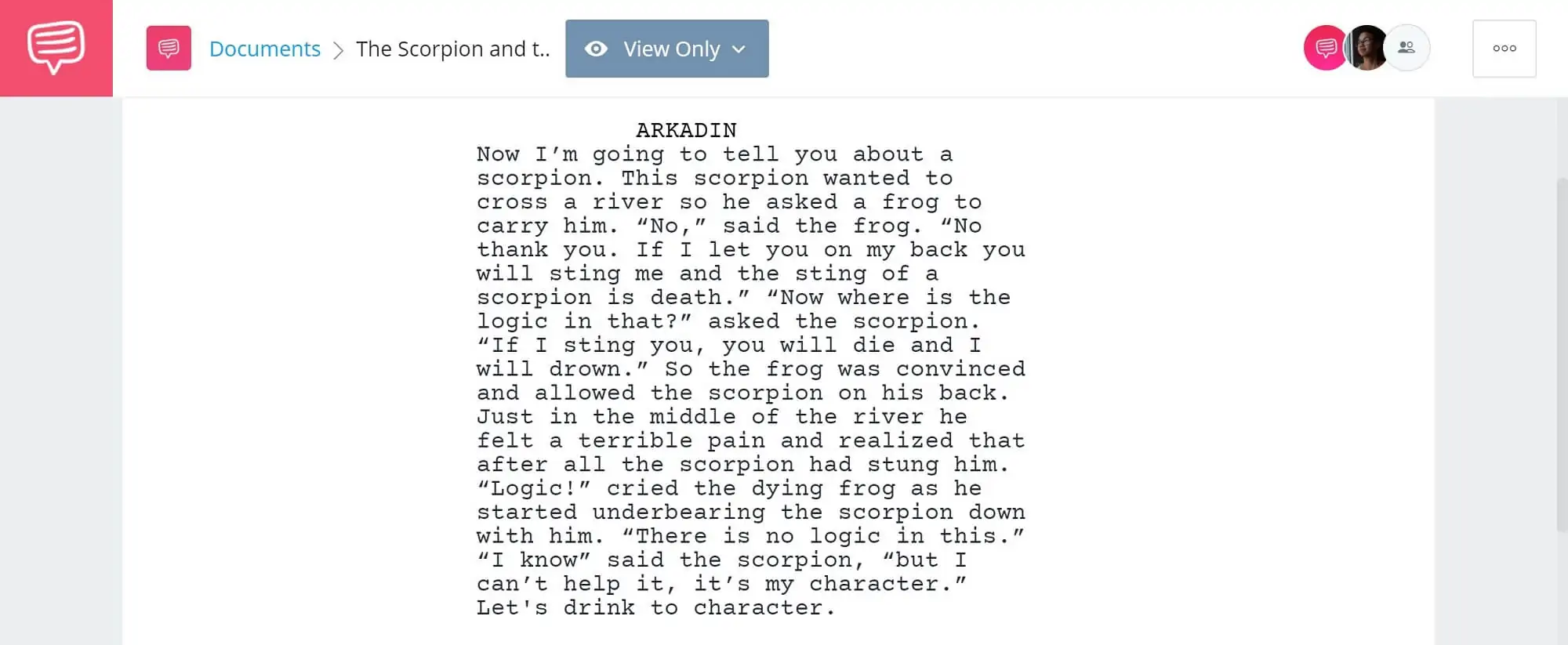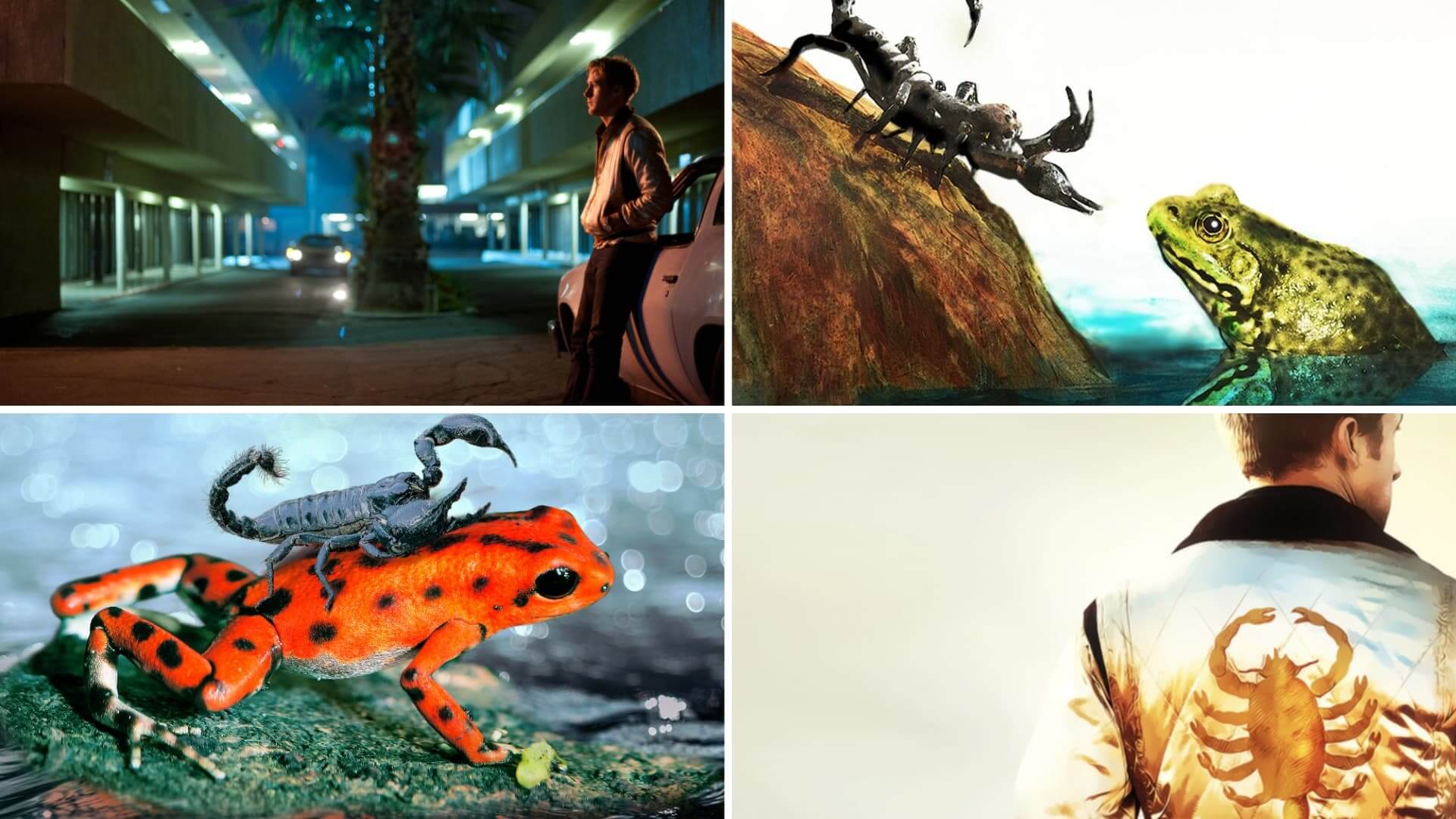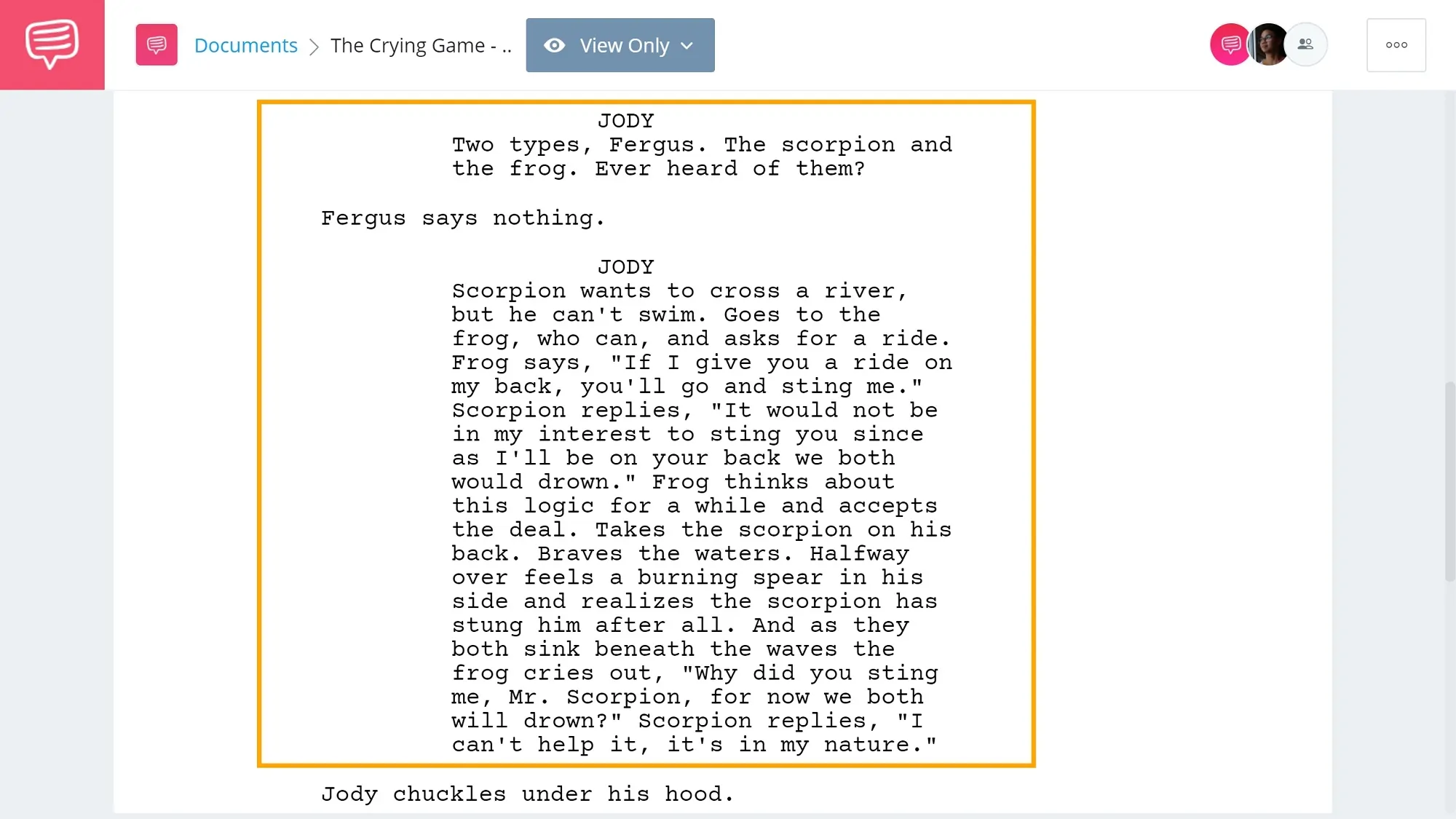The Scorpion and the Frog story is a classic fable that has only become popular over the last hundred or so years. But just like the most famous animal fables of all-time, like the Tortoise and the Hare and the Ants and the Grasshopper, the Scorpion and the Frog is a tale that can be used to demonstrate, subvert, and communicate character archetypes. We’re going to explore some examples of how the Scorpion vs Frog has been used in film – but first let’s define fables.
The Scorpion Frog Story is a Fable
A primer on interpreting fables
Before we get into the Frog and the Scorpion story, let’s take a moment to review what fables are and how we interpret their meaning. A fable is a non-literal story that features talking animals. The goal of a fable is to leave the audience with an instructional message, aka moral.
We interpret the moral of a fable by analyzing the end result of the story. This next video compares fables to myths, legend and fairy tales to clear up any confusion.
Frog vs. Scorpion • Myths, Fables, Legends, and Fairy Tales
Okay, now that we’ve reminded ourselves of what a fable is, let’s talk about the origins of the Scorpion and the Frog fable, its history in film and how screenwriters might be able to use similar fables in character development.
THE FROG AND THE SCORPION
What is the Scorpion and the Frog?
The Scorpion and the Frog is a Russian fable that was popularized by Orson Welles in the 1955 movie Mr. Arkadin, otherwise known as Confidential Report. The fable describes the relationship between an idealistic frog and a malicious scorpion, who despite their hesitations, can’t reject their primal nature.
The Scorpion and the Frog in Film
- Drive (2011)
- The Crying Game (1992)
- Mr. Arkadin (1955)
The Fable's Inception
Scorpion and the Frog in Mr. Arkadin
Many people have asked the question: who wrote the Scorpion and the Frog fable? And although there’s no definitive answer, we can trace the fable’s popularization back to one specific work.
Orson Welles’s 1955 film Mr. Arkadin was one of the earliest known pieces of popular entertainment to use the fable. Check out the clip below:The Scorpion and the Frog Story in Mr. Arkadin
Here's the scene transcribed. You'll notice that Welles doesn't just recite the story verbatim, he makes it his own. This is a key for any writer looking to adapt fables like this into their scripts. How would your protagonist express the fable compared to how the antagonist's version?

Mr. Arkadin • Frog & Scorpion Monologue
The Scorpion and the Frog fable plays an integral role in communicating the subtext of Mr. Arkadin. It asks us to question: what is the film’s true nature? Who is Mr. Arkadin? Is Mr. Arkadin nothing more than a symbol for primal nature? Perhaps – for a more thorough perspective, I suggest reading our list of the Best Orson Welles Movies.
The Story of the Frog and Scorpion
Use the fable to demonstrate character
The Scorpion and the Frog can be used subtextually to demonstrate innate aspects of characters. We imported The Crying Game screenplay into StudioBinder’s screenwriting software to take a closer look at one of the most famous examples of the Frog and the Scorpion cinema.
In this scene, Jody (Forest Whitaker) tells Fergus (Stephen Rea) the story of the Frog and the Scorpion. As you’re reading, think about why Jody tells Fergus this story. Is it out of altruism? Is it a guilt trip? Or is it purely used as a means of subtext?
The Crying Game • Frog & Scorpion Monologue
Here’s what I’d say about the use of the scorpion and the frog in The Crying Game: it’s always good to have hidden meaning in dialogue. We often critique movies when they’re too simple or rely too much on genre tropes and cliches. So how can screenwriters make stories feel refreshing and new? One way is to utilize literary devices like fables. Let’s watch the scene from the film to see how it looks on screen.
Frog vs Scorpion in The Crying Game
Perhaps it sounds backwards to suggest using fables to make stories feel new – but it’s not the fables themselves that make stories feel new but rather the unique application of the fables towards creating mood. The mood in this scene from The Crying Game is somber and serious. Maybe it would be helpful to look at another example of a scene that uses the Scorpion and Frog fable to create a different mood.
Subvert Cliche With Fables
Use the fable to subvert expectations
In this next example, the Scorpion vs Frog is referenced in the TV show After Life – and it offers a decidedly different mood than the example from The Crying Game.
A comedic take on the fable in After Life
The After Life example of the fable is intended to reassure Tony (Ricky Gervais). He’s not the malicious self-destructive scorpion he thought he was but instead the sensitive trusting frog he thought he was destroying.
Another novel application of the frog vs scorpion fable comes in video-game form; in Sony Santa Monica’s God of War. In this example, Kratos tells his son about the Scorpion and Frog in order to impart some wisdom – but it’s also used as a means of foreshadowing future events. Watch this next clip and pay attention to how the Norse Gods are metaphorized as the scorpion.The fable even turns up in God of War
The major theme of the Scorpion and the Frog – aka the folly of trust in a cynical world – is exposed in God of War. Essentially, the moral is that you shouldn’t trust the Gods if you want to stay alive.
StoryTelling Technique
Scorpion and the Frog as an allegory
An allegory is a storytelling technique that’s used to convey something symbolic to the audience – but unlike metaphors, allegories are used throughout a story to reinforce the major tenets of the symbolism.
The Scorpion-Frog fable can be used as an allegory to comment on themes involving trust, power, and nature. Sam Cooney, a YouTube video essayist, argues that the 2011 movie Drive is an allegory of the famous fable; one in which the Driver (Ryan Gosling) is the frog who ferries scorpions.
Drive: Who is the Scorpion and who is the Frog?
What do you think? Is Drive an allegorical tale of the Scorpion of the Frog? It seems impossible that the Driver’s scorpion jacket could be a coincidence – but then again it’s never explicitly stated in the script that the Driver has a scorpion jacket. Could Nicolas Winding Refn have decided to give the Driver a scorpion jacket? Maybe a costume designer did – or even Gosling himself.
The point is that you can use the Frog vs Scorpion, or any fable for that matter, to add nuance to your own story. You can use the fable as a metaphor, subtext, or an allegory. Consider the films, shows, and games we’ve gone over here when thinking about adding the fable to your production!
UP NEXT
Plato’s Allegory of the Cave
The Scorpion-Frog fable is a symbolic story that’s only become popular in recent history. To understand narrative symbolism more completely, we have to go back all the way to ~400 BC and read the works of the great philosophers. In this article, we break down one of the most famous allegories of all-time, Plato’s Allegory of the Cave – a story that every screenwriter should know.
Up Next: Read the Allegory of the Cave →
Showcase your vision with elegant shot lists and storyboards.
Create robust and customizable shot lists. Upload images to make storyboards and slideshows.

